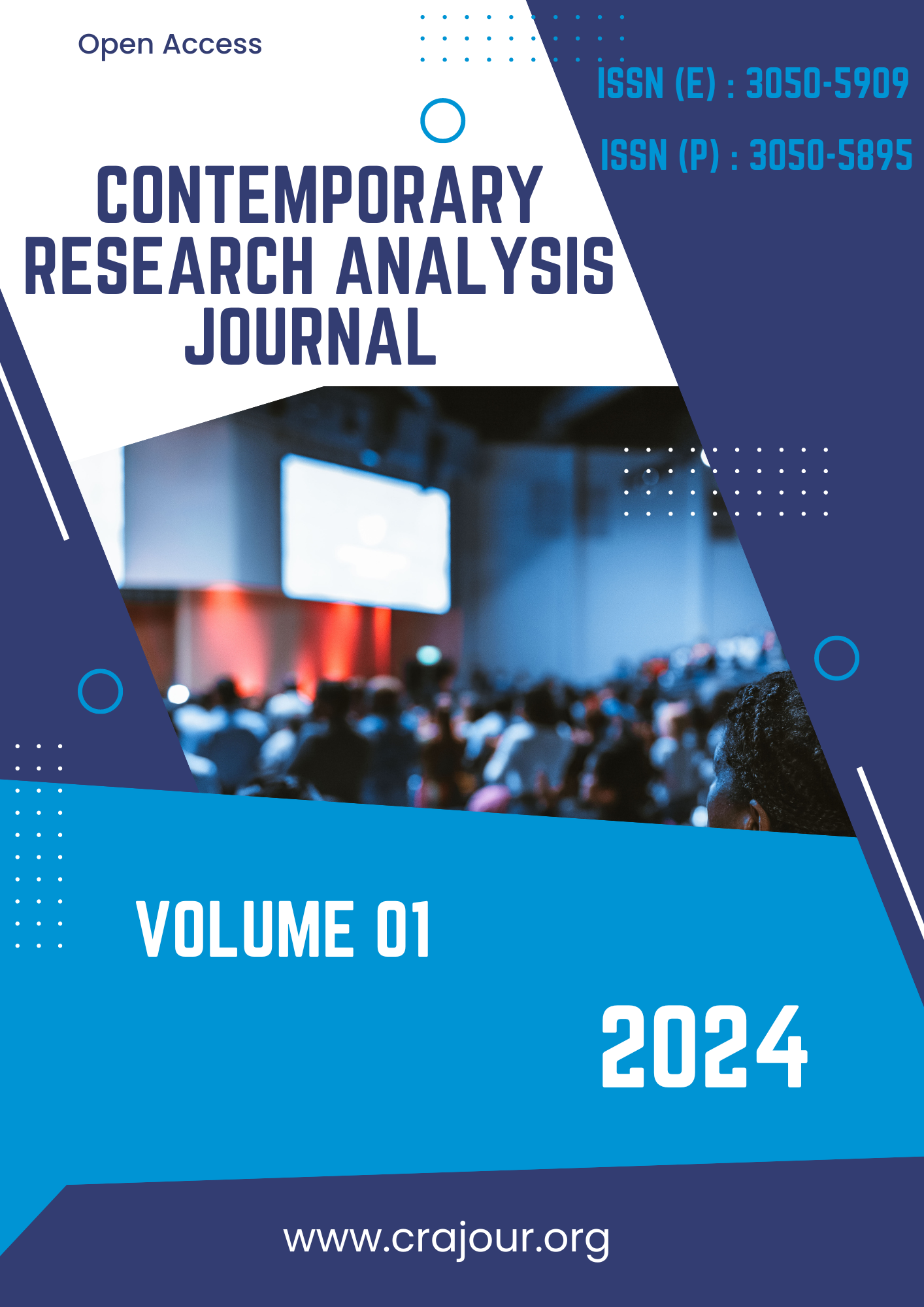The Role of Spirituality on Ambivalent Behaviors Among Christian Youth Attending Selected Churches in Kajiado County, Kenya
DOI:
https://doi.org/10.55677/CRAJ/02-2024-Vol01I4Keywords:
Youth, Spirituality, Substance use, Sexual behaviors, Ambivalent,CorrelationAbstract
The role of spirituality in mitigating against ambivalent behaviors among Christian youth needs to be studied, with an aim to devising efficacious intervention programs, that can be escalated to other non-Christian youth.
This study aimed at investigating the relationship between ambivalent behaviors (substance use and sexual behaviors) and spirituality (strength of faith and religious coping mechanisms) among the Christian youth attending four selected Churches in Kajiado County, Kenya.
Through a descriptive research design, data was collected from 145 respondents aged 14-35 years (73 male,72 female) who were regularly attending Sunday services. Data collection instruments were the Santa Clara, to assess strength of faith, the Religious Coping Questionnaire (BRIEF-COPE) to assess the religious coping mechanisms, the Compulsive Sexual Behavior Inventory (CSBI) for sexual impairment and the Alcohol, Smoking and Substance Involvement Screening Test - Lite (ASSIST-Lite) for substance use.
Data was analysed quantitatively using the statistical package for social sciences (SPSS, version 29) utilizing Kendall’s tau-b, and scatter plots were generated to assess the nature of the relationship between spirituality and ambivalent behaviors.
Findings pointed to a positive statistically significant relationship between sexual behaviors and negative religious coping (τb=.223, 95% C.I .117-.324, p=.008) showing that increased use of negative coping mechanism was related to increased sexual behaviors. The scatter plots showed that overally, ambivalent behaviors had a weak negative relationship with positive coping mechanisms (R2=1.1%) and strength of faith(R2=1.1%), and a weak but positive relationship with negative coping (R2=2.1%). There were several outliers in all the three scatter plots, showing a non-linear relationship implying that other factors were related to the ambivalent behaviors aside from the spirituality.
The findings thus pointed to a moderate correlation between spirituality and ambivalent behaviors, where increased faith and use of positive coping mechanisms can mitigate against ambivalent behaviors, but there is also need for additional programs that could directly address the underlying causes, as well as the propagating factors.
The study thus recommends a multi-faceted approach, incorporating psychological programs alongside the spiritual nurture, to address ambivalent behaviors among Christian youth. Such programs have the potential to be escalated to other non-Christian youth.
References
Addy, N. D., Agbozo, F., Runge-Ranzinger, S., & Grys, P. (2021). Mental health difficulties, coping mechanisms and support systems among school-going adolescents in Ghana:A mixed-methods study. PLoS one, 16(4), e0250424.
Ali, R., Meena, S., Eastwood, B., Richards, I., & Marsden, J. (2013). Ultra-rapid screening for substance-use disorders: The Alcohol, Smoking and Substance Involvement Screening Test (ASSIST-Lite). Drug and Alcohol Dependence, 132(1-2), 352-361. https://doi.org/10.1016/j.drugalcdep.2013.03.001.
Arndt, N., & Naudé, L. (2016). Contrast and contradiction: Being a black adolescent in contemporary South Africa. Journal of Psychology in Africa, 26(3), 267-275. doi: 10.1080/14330237.2016.1185913
Büssing, A., Föller‐Mancini, A., Gidley, J., & Heusser, P. (2010). Aspects of spirituality in youth. International Journal of Children's Spirituality, 15(1), 25-44. doi: 10.1080/13644360903565524
Cheung, C. K., & Yeung, J. W. K. (2011). Meta-analysis of relationships between religiosity and constructive and destructive behaviors among youth. Children and Youth Services Review, 33(2), 376-385.
Coleman, Michael Miner, Fred Ohlerking, Nancy Raymond, E. (2001). Compulsive Sexual Behavior Inventory: A preliminary study of reliability and validity. Journal of sex & marital therapy, 27(4), 325-332.
Dalmida, S., Aduloju-Ajijola, N., Clayton-Jones, D., Thomas, T. L., Erazo Toscano, R. J., Lewis, R., ... Lunyong, M. (2018). Sexual risk behaviors of African American adolescent females: The role of cognitive and religious factors. Journal of Transcultural Nursing, 29(1), 74-83. doi: 10.1177/1043659616678660
Dariotis, J. K., & Chen, F. R. (2022). Stress coping strategies as mediators: toward a better understanding of sexual, substance, and delinquent behavior-related risk-taking among transition-aged youth. Deviant behavior, 43(4), 397-414.
Edwards, L. M., Lapp-Rincker, R. H., Magyar-Moe, J. L., Rehfeldt, J. D., Ryder, J. A., Brown, J. C., & Lopez, S. J. (2002). A positive relationship between religious faith and forgiveness: Faith in the absence of data? Pastoral Psychology, 50(3), 147-152.
Eppelmann, L., Parzer, P., Lenzen, C., Bürger, A., Haffner, J., Resch, F., & Kaess, M.(2016). Stress, coping and emotional and behavioral problems among German high school students. Mental Health & Prevention, 4(2), 81-87.
Francis, L. J. (2020). Churchgoing and Christian Ethics: An Empirical Study among 13- to 15-Year-Old Students in England and Wales. Journal of Empirical Theology, 33(2), 197-219. https://doi.org/10.1163/15709256- 12341410Farnsworth K.E. (1985). Wholehearted Integration- Harmonizing Psychology and Christianity through Word and Deed. Baker Book House.
Hardy, S. A., Morgan, M., Nelson, J. M., & Schwadel, P. (2023). Unpacking the role of adolescent religious affiliation in youth outcomes. Journal of Adolescence, 95(7), 1528-1536.
Harley, D., & Hunn, V. (2015). Utilization of photovoice to explore hope and spirituality among low-income African American youth. Child and Adolescent Social Work Journal, 32, 3-15.
Hartberg, S., Clench-Aas, J., Raanaas, R. K., & Lundqvist, C. (2015). Coping strategiesamong adolescents with chronic headache and mental health problems: a cross- sectional population-based study. Springerplus, 4, 1-11.
Hayward, G. M. (2019). Religiosity and premarital sexual behaviors among youth: An analysis of functional form. Journal for the Scientific Study of Religion, 58(2), 439-458.
Hollar, M. K., Brubaker, M. D., Richardson, G., & Alvarez, J. (2023). Social predictors of marijuana use among African American youth. Journal of Addictions & Offender Counseling, 44(2), 98-112.
Hur, Y. M., Jeong, H. U., Ajose, F., & Knafo-Noam, A. (2019). Religious attendance moderates the environmental effect on prosocial behavior in Nigerian youth. Twin Research and Human Genetics, 22(1), 42-47.
Kaufman, C. C., Berlin, K., Okwumabua, T., & Thurston, I. (2023). Spirituality and Religiosity Profiles among Diverse Young Adults: The Relationship with Meaning Making. Journal of Spirituality in Mental Health, 25(2), 83-103.
Khodayarifard, M., Mansouri, A., Besharat, M. A., & Gholamali Lavasani, M. (2020). The standardization of spiritual coping questionnaire in student population. Journal of Fundamentals of Mental Health, 21(4), 221-231.
Kim, I., Park, Y., Chasek, C., Bjornsen, A., & Shin, K. (2024). Recovery from substance use disorder among youth: Roles of adverse and positive childhood experiences. The Journal of Addictions & Offender Counseling,1–14. https://doi.org/10.1002/jaoc.12136
King, U. (2013). The spiritual potential of childhood: Awakening to the fullness of life. International Journal of Children's Spirituality, 18(1), 4-17. doi: 10.1080/1364436X.2013.776266
Leshem, R. (2016). Brain development, impulsivity, risky decision making, and cognitive control: Integrating cognitive and socioemotional processes during adolescence - An Introduction to the special issue. Developmental Neuropsychology, 41(1-2), 1-5. doi: 10.1080/87565641.2016.1187033
Magidson, J. F., Dietrich, J., Otwombe, K. N., Sikkema, K. J., Katz, I. T., & Gray, G.E. (2017). Psychosocial correlates of alcohol and other substance use among low-income youth in peri-urban Johannesburg, South Africa: A focus on gender differences. Journal of health psychology, 22(11), 1415-1425.
Mathai, L. M. (2022). Addressing the prevalence of alcohol and drug abuse among the youth in the Presbyterian churches in Kenya. Journal of Humanities and Social Sciences (JHSS), 1(1), 21-34.
Mayordomo-Rodríguez, T., Meléndez-Moral, J. C., Viguer-Segui, P., & Sales-Galán, A. (2015). Coping strategies as predictors of well-being in youth adult. Social Indicators Research, 122, 479-489.
Miedema, S. S., Stamatakis, C., Tracy, A., Hegle, J., Kamagate, M. F., McOwen, J., ... & Annor, F. B. (2024). Patterns of adverse childhood experiences and their associations with mental distress, substance use and sexual risk behaviors in Sub-Saharan Africa. Child Abuse & Neglect, 150, 106494.
National Study of Youth & Religion (2024) https://youthandreligion.nd.edu/related-resources/preliminary-research-findings/significant-numbers-of-religiously-active-teenagers-are-involved-in-serious-risk-behaviors-involving/
Nguyen, V.T. & Nguyen, C.T.P. (2023), “Self-compassion and life satisfaction in Vietnamese youth: the mediating role of emotional and behavioral problems”, Mental Health and Social Inclusion, Vol. ahead-of-print No. ahead- of-print. https://doi.org/10.1108/MHSI-07-2023-0076
Olaore, A. Y. (2013). Youth, religiosity and substance abuse: A Nigerian private university experience. Research on Humanities and Social Sciences, 3(16), 83- 86.
Patston, L. L. M., Travers, K. A., & Newcombe, D. A. L. (2017). The Acceptability and Feasibility of Screening for Alcohol and Drug Misuse in a Hospital Emergency Department. Addictive disorders & their treatment, 16(3), 111–120. https://doi.org/10.1097/ADT.0000000000000108
Scott Jr, L. D., Hodge, D. R., White, T., & Munson, M. R. (2018). Substance use among older youth transitioning from foster care: Examining the protective effects of religious and spiritual capital. Child & Family Social Work, 23(3), 399-407.
Scott Jr, L. D., Hodge, D. R., White, T., & Munson, M. R. (2018). Substance use among older youth transitioning from foster care: Examining the protective effects of religious and spiritual capital. Child & Family Social Work, 23(3), 399-407.
Scott Jr, L. D., Hodge, D. R., White, T., & Munson, M. R. (2018). Substance use among older youth transitioning from foster care: Examining the protective effects of religious and spiritual capital. Child & Family Social Work, 23(3), 399-407.
Storholm ED, Fisher DG, Napper LE, Reynolds GL, Halkitis PN. A Psychometric Analysis of the Compulsive Sexual Behavior Inventory. Sex Addict Compulsivity. 2011;18(2):86-103. doi: 10.1080/10720162.2011.584057. Epub 2011 Jun 9. PMID: 36919045; PMCID: PMC10010680.
Swindell, J. S. (2010). Ambivalence. Philosophical Explorations, 13(1), 23-34. doi: 10.1080/13869790903318516
Vasilenko, S. A., & Espinosa‐Hernández, G. (2019). Multidimensional profiles of religiosity among youth: Associations with sexual behaviors and romantic relationships. Journal of Research on Adolescence, 29(2), 414-428.
Wachira, J. R., (2016). Effect of Religiosity on the Trends and Prevalence of Substance Use and Abuse among Youth A Case of Selected Churches in Westlands Sub-County, Nairobi, Kenya.Daystar University, School of Human and Social Sciences.
Wen, M. (2017). Social capital and adolescent substance use: the role of family, school, and neighborhood contexts. Journal of Research on Adolescence, 27(2), 362- 378.
Zhang, S., Lefmann, T., Lim, Y., Robbins, C. S., & Zhang, L. (2024). Religiosity’s Links to Adolescent Wellbeing and the Role of Supportive Networks and Sex. Youth & Society, 0044118X241273363.
Downloads
Published
Issue
Section
License
Copyright (c) 2024 Contemporary Research Analysis Journal

This work is licensed under a Creative Commons Attribution 4.0 International License.



